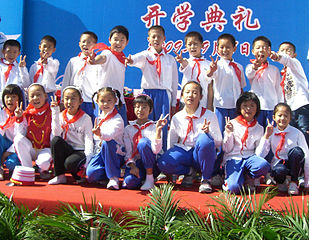 Who do you think are healthier: people born and raised in China, or in the USA? I used to generalize that the average person in China was healthier, mostly from observing Beijing’s lively street life, especially at night. On every street corner you see families, friends and neighbors dance en masse, sing along to classic tunes, and chat away while walking — often backwards. This happens every night in every season — in every city I’ve seen across China. It fits with a well known Chinese proverb 饭后百步走,活到九十九 (take a hundred steps after eating, live to be 99). It’s a wonderful cultural tradition!
Who do you think are healthier: people born and raised in China, or in the USA? I used to generalize that the average person in China was healthier, mostly from observing Beijing’s lively street life, especially at night. On every street corner you see families, friends and neighbors dance en masse, sing along to classic tunes, and chat away while walking — often backwards. This happens every night in every season — in every city I’ve seen across China. It fits with a well known Chinese proverb 饭后百步走,活到九十九 (take a hundred steps after eating, live to be 99). It’s a wonderful cultural tradition!
So from this wonderful nightly visual, I assumed that Chinese exercise a lot more than Americans — but the actual data doesn’t reflect this casual observation. Not even close, in fact. Only 6 percent of people in China aged 20 to 39 got the proper amount of exercise (the goal is 90 minutes a week of moderate activity). This is far lower than the 26% in Americans aged 19-44. This is also lower than their elders, which confirms the commonly noted observation that elderly Chinese get more exercise than the new generation — just the opposite of America. In China, 10% of people aged 50 to 69 carried out regular exercise, more than the 6% of their children and grandchildren. In the USA, 14% of persons age 65-74 got the recommended exercise, much less than the younger adult 26% rate.
The exercise rates in teens and earlier years are better, mostly because of the built-in school activities, but it tails off quickly in the teen years. With Hong Kong teens, for example, 64% of boys and 40% of the girls achieved the recommended 60 minutes of exercise daily after school. These are higher than in the US, with 37% (45.6% in boys and 27.7% in girls) achieving their daily 60 minutes. With weight, around 7.5% of Chinese children are obese and another 13% overweight; this is still much better than in the USA, where 17% are obese.
Why does activity drop off so quickly for kids in China after middle school? One theory is the incredible amount of studying that Chinese students are accustomed to: children in Shanghai and Hangzhou between grades 4 and 8 spend an average of 150 to 160 minutes doing homework every weekday and more than 200 minutes on weekends. In addition, children spend an average of more than 60 minutes every weekday sitting still and playing on computers, cell phones, tablets and watching TV. That’s an astonishing amount of homework, far more than the amounts I and my American friends and relatives ever had. In the UK, 9 to 11 year olds are expected to get 30 minutes a day of homework, going up to 90-150 minutes a day in high school.
A 2010 China Daily article about this issue agreed that “China’s exam-obsessed education system is taking much of the blame for the deterioration in students’ conditions. “It’s the root reason,” said Sun Yunxiao, deputy director of the China Youth and Children Research Center. “The emphasis is on test scores, not physical well-being. Pupils are being assigned too much homework, leaving no time for exercise.” This brings up an interesting and important topic of debate: what provides the better long term health for a child — a good education or proper exercise habits? After all, many studies show that higher education improves long term health, but studies also show that exercising is crucial for lowering lifetime risks of overall death, heart disease, cancers, diabetes and many other diseases. This imbalance is especially concerning since there is no strong evidence that more homework equals more lifetime success. In fact, many experts feel quite the opposite is true, especially during primary school ages. The American Academy of Pediatrics released a report in 2006 stressing that, “the most valuable and useful character traits that will prepare their children for success arise not from extracurricular or academic commitments but from a firm grounding in parental love, role modeling, and guidance.”
This article is in the current edition of Beijingkids magazine. You can read all my previous Beijingkids articles here. It’s an abridged version of an earlier article I wrote last year for my New York Times column.
Follow me on Facebook: @BainbridgeBabaDoc
Photography: www.richardsaintcyr.com